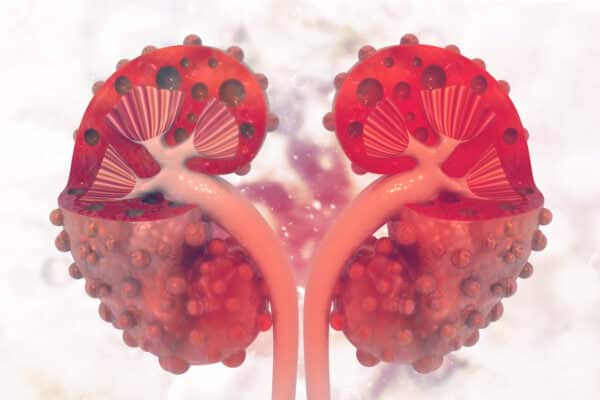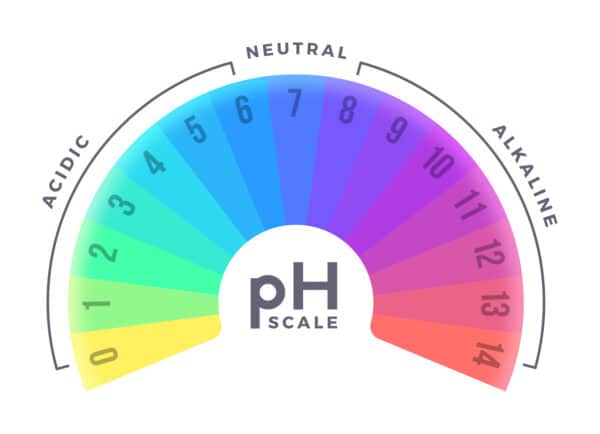
SS-31 Peptide and Kidney Disease

Kidney disease is a global health concern. The kidneys, especially the proximal tubules, contain high mitochondrial density. This is due to the high amount of ATP required for solute reabsorption, the removal of blood waste products, and fluid and electrolyte balance. SS-31 is a peptide used to target mitochondria, and it has been found to protect the kidneys from oxidative stress, inflammation and apoptosis. SS-31 has been shown to reduce acute kidney injury, diabetic nephropathy and chronic kidney disease (CKD) in animal models.
What are Peptides?
Peptides are short chains of amino acids, which are the building blocks of proteins. Peptides can vary in length from a few amino acids to several dozen. They have a wide range of bodily functions and play an essential role in various biological processes.
What is The SS-31 Peptide?
SS-31 peptide is a small, cell-permeable peptide that targets mitochondria. Mitochondria are the energy-producing powerhouses within a cell. The kidney is a vital organ, and it requires a load of energy to carry out its daily activities, such as maintaining body metabolism, plasma haemodynamics, nutrient reabsorption, secreting certain hormones, and regulating blood pressure and water and electrolyte balance. After the heart, the kidney comes second in mitochondrial count and oxygen consumption. Energy demands within the renal cells are tailored to each specific cellular function. Cellular energy demands are met mainly by mitochondria, where we see the bidirectional relationship between the two. Mitochondrial dysfunction is associated with almost all types of kidney disease.
Mitochondrial dysfunction in kidney diseases – ScienceDirect

Image via Mitochondria (genome.gov)
SS31 is believed to have several potential benefits:
- Mitochondrial protection– Healthy mitochondria are essential for overall health, energy production, and overall cellular function. SS-31 has been researched for its ability to protect the mitochondria from the damage caused by oxidative stress in disease states.
- Antioxidant effects– SS31 is known for its antioxidant properties, meaning it can inhibit mitochondrial swelling or oxidative cell death by reducing the production of mitochondrial reactive oxygen species (ROS)
- Cardioprotective effects– SS31 has been shown to reduce oxidative stress within the heart. It has been shown to benefit cardiovascular diseases such as myocardial ischemia/reperfusion injury, heart failure and doxorubicin-induced cardiotoxicity. Ischemia reperfusion injury is when the blood flow is temporarily restricted and then restored. This will often occur during heart surgeries or heart attacks.
- Neuroprotective effects– Research has explored the potential of SS-31 in protecting neurons and reducing oxidative stress in neurogenerative diseases such as Alzheimer’s and Parkinson’s disease. SS-31 improves cognitive function by supporting mitochondrial and synaptic health, decreasing inflammation pyroptosis (programmed cell death). These effects have not yet been confirmed in humans.
SS-31-Cognitive-Vitality-For-Researchers.pdf (alzdiscovery.org)
Drug Interactions
Drug interactions with SS-31 have not been well documented.
Safety
Adverse events are mild. The most common effect is seen at the site of injection. This includes erythema (57%), pruritis (47%), pain (20%), urticaria (20%) and irritation (10%). Dizziness and headaches have also been observed. Treatments longer than four weeks have not been studied; therefore, long-term safety has not been established in humans.
SS-31-Cognitive-Vitality-For-Researchers.pdf (alzdiscovery.org)
SS-31, a Mitochondria-Targeting Peptide, Ameliorates Kidney Disease – PMC (nih.gov)
How does SS-31 Work?
Mitochondrial dysfunction is associated with the development and progression of renal disease. In recent years, the effect of mitochondrial targeting pharmacological strategies has been studied in disease states. Other mitochondrial targeting drugs include nicotinamide mononucleotide, MitoQ, CoQ10 and cyclosporin A. However, it has been found that the traditional drugs that target mitochondria have limited clinical applications. This is due to their inability to absorb mitochondria in vivo effectively and their high toxicity.
Recently, SS-31 has gained particular interest as it can decrease mitochondrial ROS production, preventing mitochondrial depolarization, mitochondrial permeability transition pore formation, and Ca2+-induced mitochondrial swelling, and has also been found not to affect normal mitochondrial function.
SS-31, a Mitochondria-Targeting Peptide, Ameliorates Kidney Disease – PMC (nih.gov)
The exact mechanism of action is continuing to be explored. Following is an overview of how it is believed to work based on current knowledge.
Let’s take a look!
Mitochondrial Protection
SS-31 can target and accumulate in the inner mitochondrial membrane, and this is where the electron transport chain and ATP production take place. SS-31 may help maintain mitochondrial membrane integrity and function, especially where we see oxidative stress and damage. Research has shown that SS-31 protects and restores mitochondrial structure, promotes ATP synthesis, and reduces electron leakage and cardiolipin peroxidation. As a result, SS-31 displays protective effects against diseases such as cardiac disease, neurological, retinal, kidney, respiratory disease, diabetes, sepsis and age-related disease states.
SS-31, a Mitochondria-Targeting Peptide, Ameliorates Kidney Disease – PMC (nih.gov)
Reduction of Reactive Oxygen Species (ROS)
Mitochondria are a major source of ROS production. This occurs during the process of oxidative phosphorylation. An excessive amount of ROS can cause damage to mitochondrial components such as proteins, lipids, and DNA, leading to mitochondrial dysfunction. A 2019 study shows SS-31 promotes mitochondria function and inhibits mitochondrial permeability transition. It has been shown to reduce inflammation and oxidative stress in type 2 diabetes. Furthermore, this study found that SS-31 keeps mitochondria integrated, inhibits apoptosis, can overturn the dysfunction of mitochondria, diminishes the inflammatory reaction and will eventually overturn the behavioural disorder in sepsis-associated encephalopathy (SAE) mice.
Anti-inflammatory Effects
We know inflammation is associated with many chronic health conditions. A study published in the Journal of Neuroinflammation concluded that SS-31 improved mitochondrial dysfunction and synaptic memory impairment induced by liposaccharides in mice. Mitochondria have a direct effect on neuronal function and survival. Oxidative stress, resulting from mitochondrial abnormalities, plays an essential role in the pathophysiology of liposaccharide (LPS)-memory impairment. Postoperative cognitive decline, now defined as perioperative neurocognitive disorder (PND), is a very common post-operative complication. PND is characterised by a decline in cognitive function in patients post anaesthesia. Surgery causes central and peripheral oxidative stress and inflammatory responses, leading to cognitive dysfunction, especially in the elderly. Previous studies have shown that oxidative stress and inflammatory responses are pivotal in the mouse memory impairment model caused by liposaccharides (LPS). SS-31 has been shown to protect against surgery and LPS administration-induced memory impairment in adult rats.
Protects Against Cell Death
Mitochondrial dysfunction can lead to cell death. SS-31 may prevent this by supporting mitochondrial function and reducing oxidative stress. It has been shown to remove ROS, which will prevent the activation of the cell death pathways.
Enhances Energy Production
By preserving mitochondrial function, SS-31 may enhance the production of adenosine triphosphate (ATP), the primary energy source of cells.
Mitochondrial protein interaction landscape of SS-31 (pnas.org)
SS-31 in Kidney Disease
The action of SS-31 against kidney disease is still not fully understood. The studies suggest it is primarily due to it protecting mitochondrial structure, repairing damaged mitochondria, scavenging ROS and increasing the production of ATP. This reduces oxidative stress, improves apoptosis, and improves the inflammatory response, autophagy and fibrosis. ROS will damage kidney cells by oxidizing membrane phospholipids, proteins, nucleic acids and carbohydrates, and this is where SS-31 plays an essential role in protecting mitochondria.
Pre-clinical evaluation of SS-31 in animal experiments against KD has been shown to have protective effects in renal diseases such as IR injury-induced AKI, drug-mediated AKI, CKD, DN, and glomerular and renal vascular-related diseases.
Atherosclerotic renal artery stenosis is a causative factor in cardiovascular disease and promotes the progression of CKD. Studies show although percutaneous renal angioplasty (PTRA) and stenting can restore blood pressure, it can not restore deteriorated kidney function. Authors investigated the effects of SS-31 in a swine atherosclerosis model, and they found an SS-31 infusion 30 minutes before and 3.5h after PTRA increased mitochondrial biogenesis, decreased PTRA-induced inflammation, oxidative stress, apoptosis and fibrosis; it also improved renal microvascular rarefaction, glomerular filtration rate (GFR), and tubular damage.
SS-31, a Mitochondria-Targeting Peptide, Ameliorates Kidney Disease (hindawi.com)
Table 1 | SS-31, a Mitochondria-Targeting Peptide, Ameliorates Kidney Disease (hindawi.com)

Image via SS-31, a Mitochondria-Targeting Peptide, Ameliorates Kidney Disease – PMC (nih.gov)
Clinical Trials
So far, current clinical studies have been focused on cardiac disease and mitochondrial myopathy, and fewer clinical studies have been dedicated to KD. However, as you can see, SS-31 shows some very promising applications in KD. As mitochondrial dysfunction is involved in the development and progression of KD and a limited number of drugs available whose effectiveness has not been thoroughly evaluated, large-scale clinical studies need to be conducted to assess the efficacy, safety, and tolerability of SS-31 for better clinical application.
There you go, everything you need to know about SS-31. If you have found this helpful article, please share it with your family or friends or head over to our Facebook page and leave us a comment, we would love to hear from you.
Share This Article
LIKE WHAT YOU’VE READ?
Sign up for free updates delivered to your inbox. Join our community and get tips on health, wellness, nutrition, and more.
More From Our Blog

The Oral Microbiome & Chronic Kidney Disease
The oral microbiome plays an essential role in the incidence and development of

Natural Therapies In The Treatment of Polycystic Kidney Disease
Regarding dietary interventions in treating and managing PKD, the science is solid. The

What Causes Cyst Formation In Polycystic Kidney Disease?
What is polycystic kidney disease? Polycystic kidney disease (PKD) is a prevalent genetic

Bicarbonate Supplements? Is It The Best Way To Alkalize in Kidney Disease?
Throughout the ages, human diets have undergone a significant transformation, shifting from an

The Big Question… Can Kidney Disease Be Reversed?
Kidney disease can range from mild to severe, so the potential for reversal

The Role of Calcium in Kidney Disease
Calcium is the most abundant mineral in our body; ninety-nine per cent of




